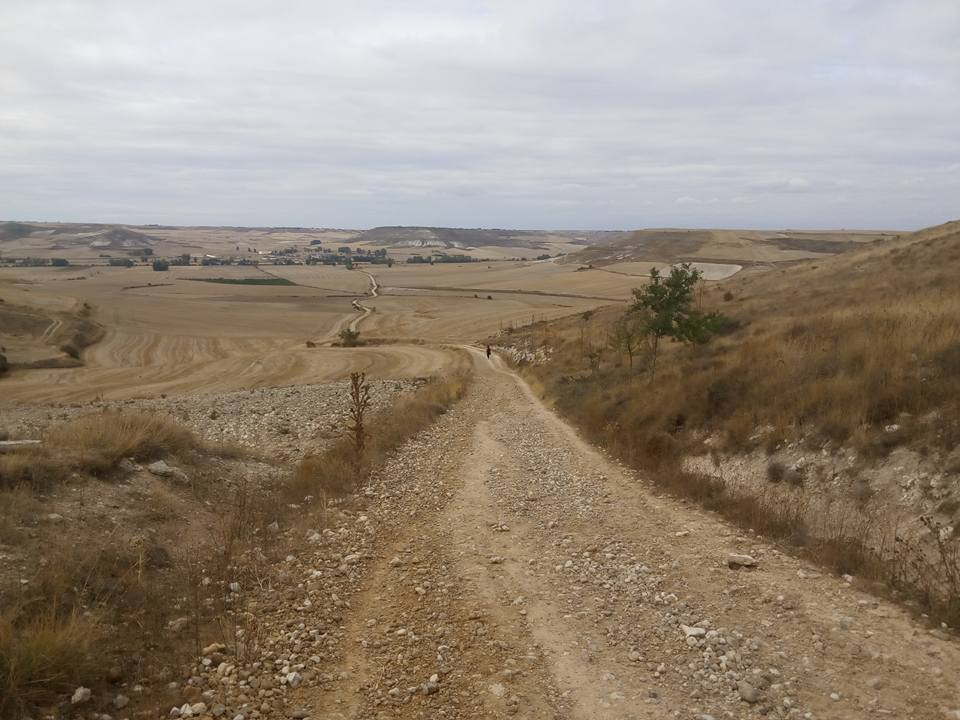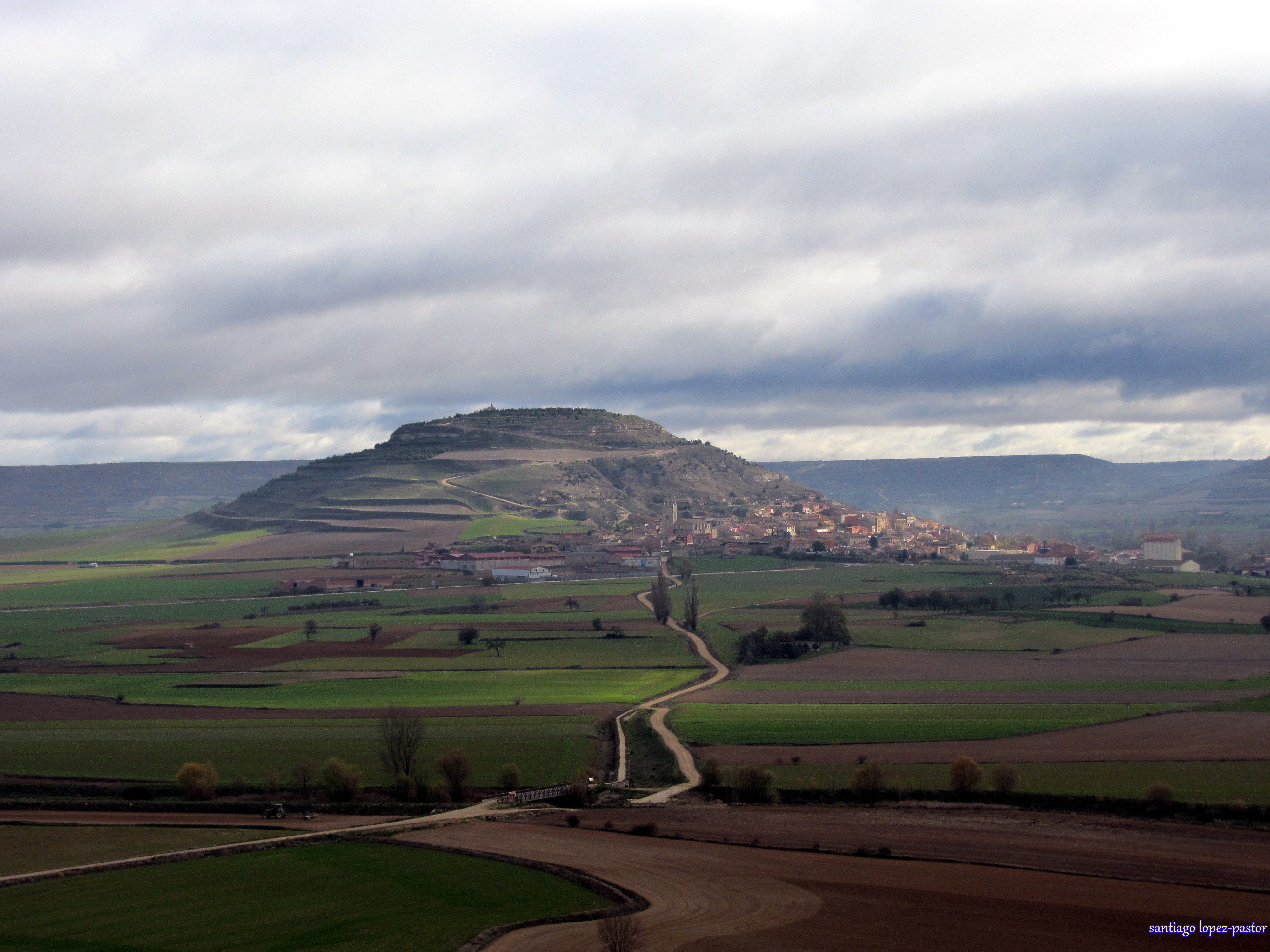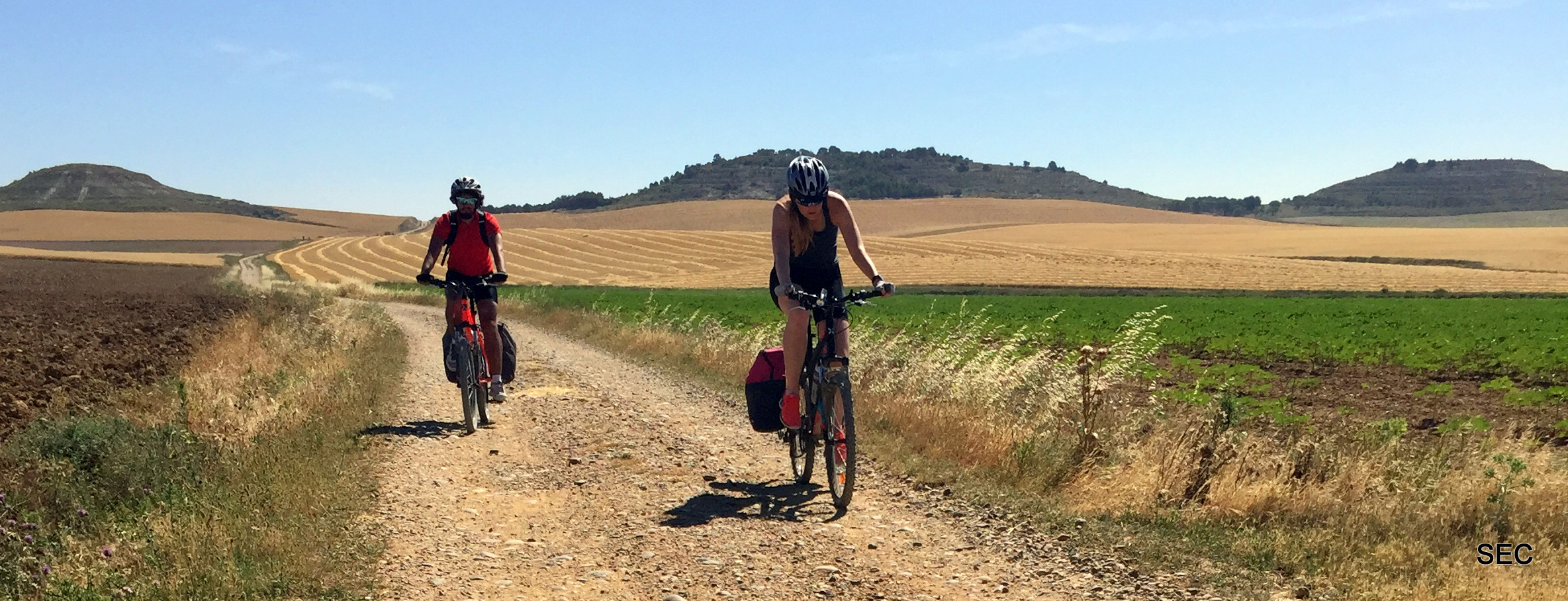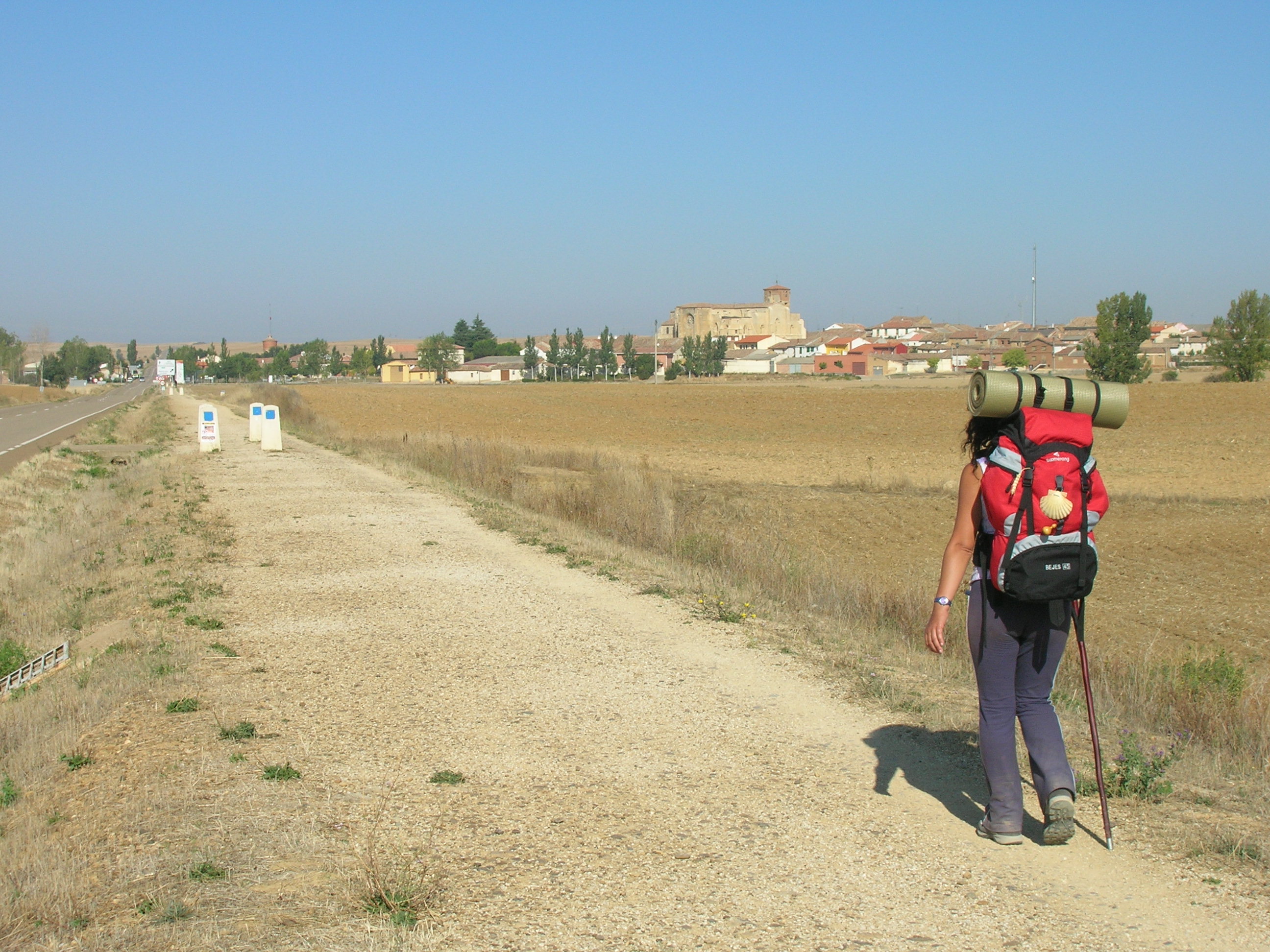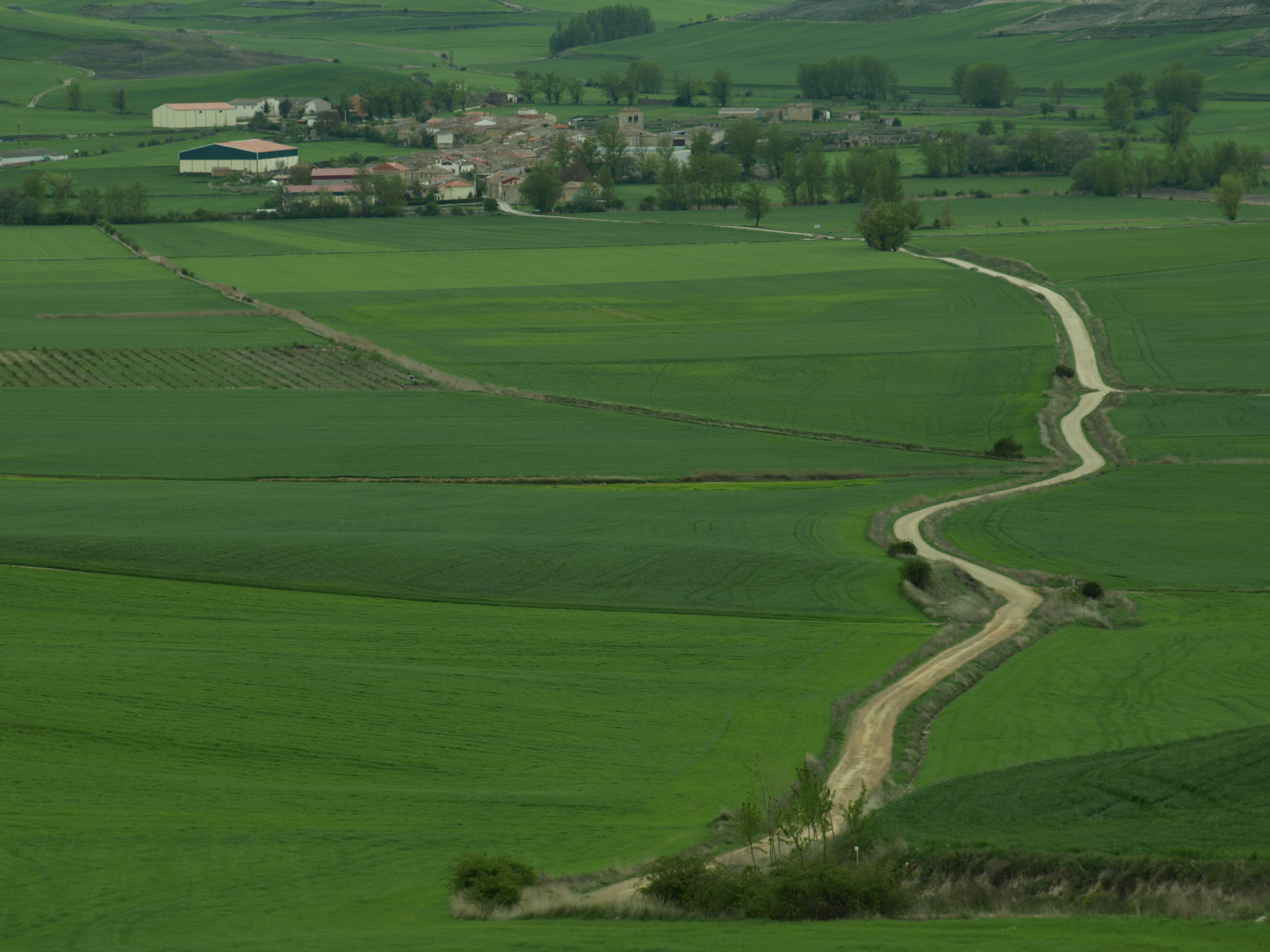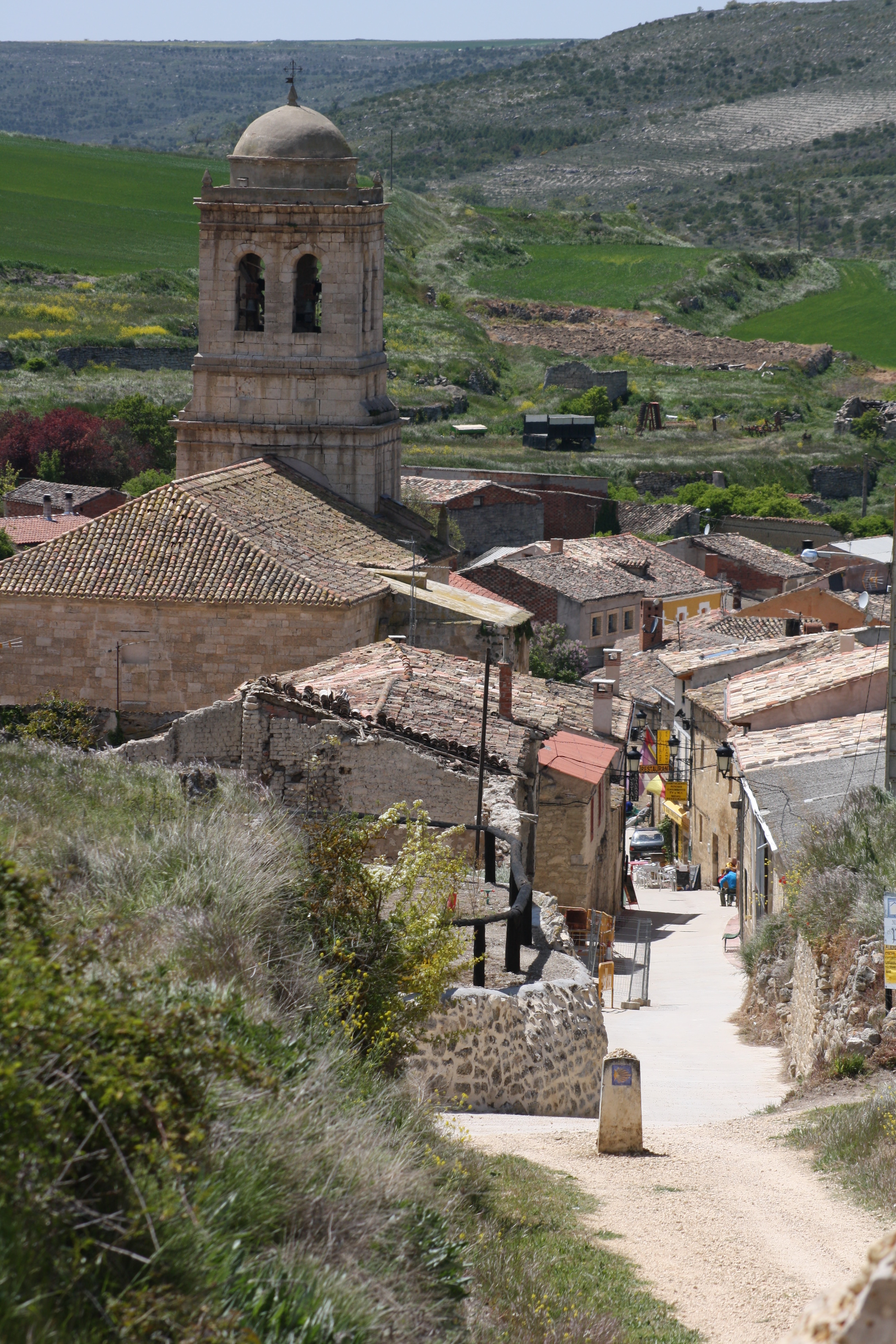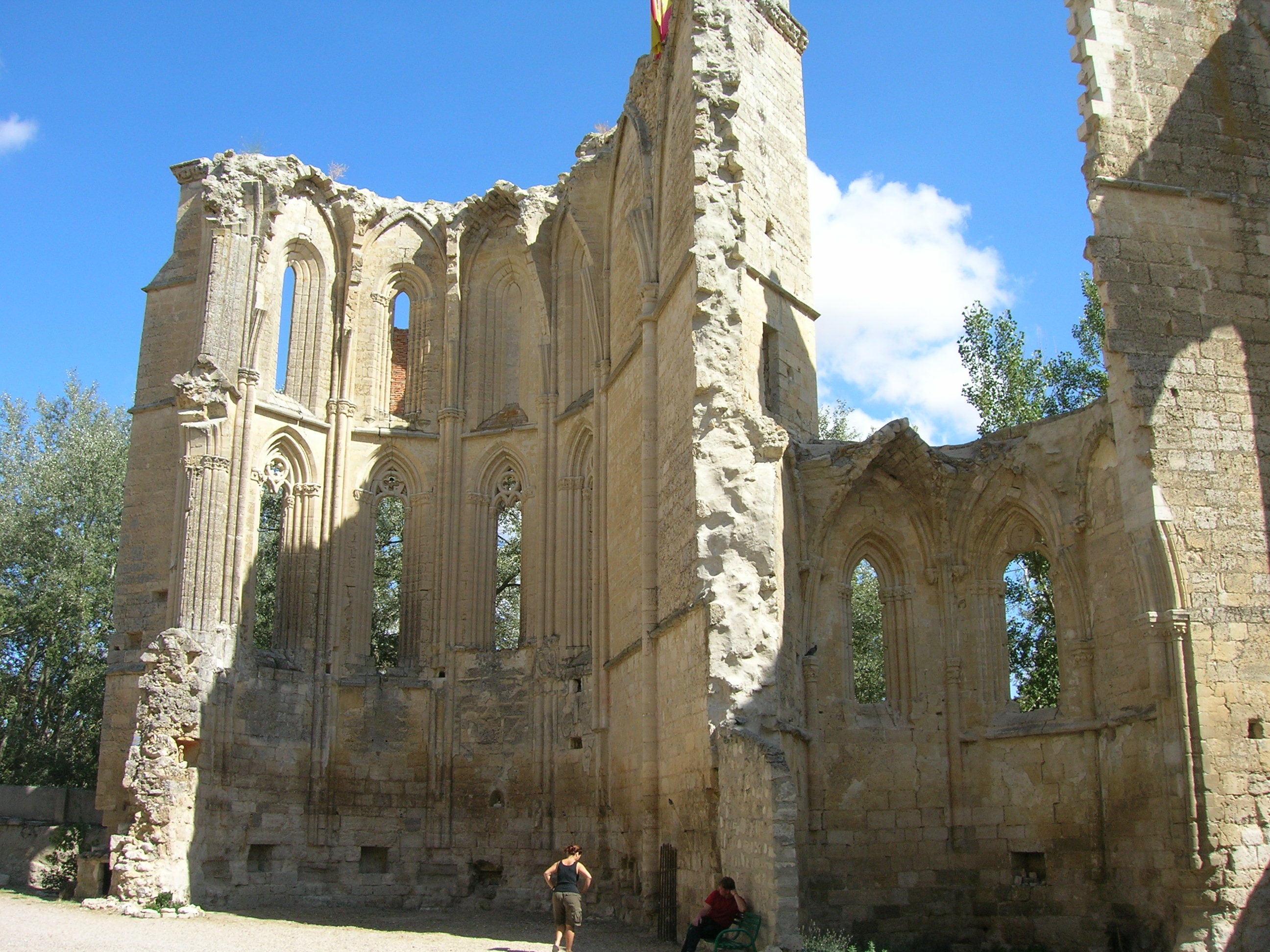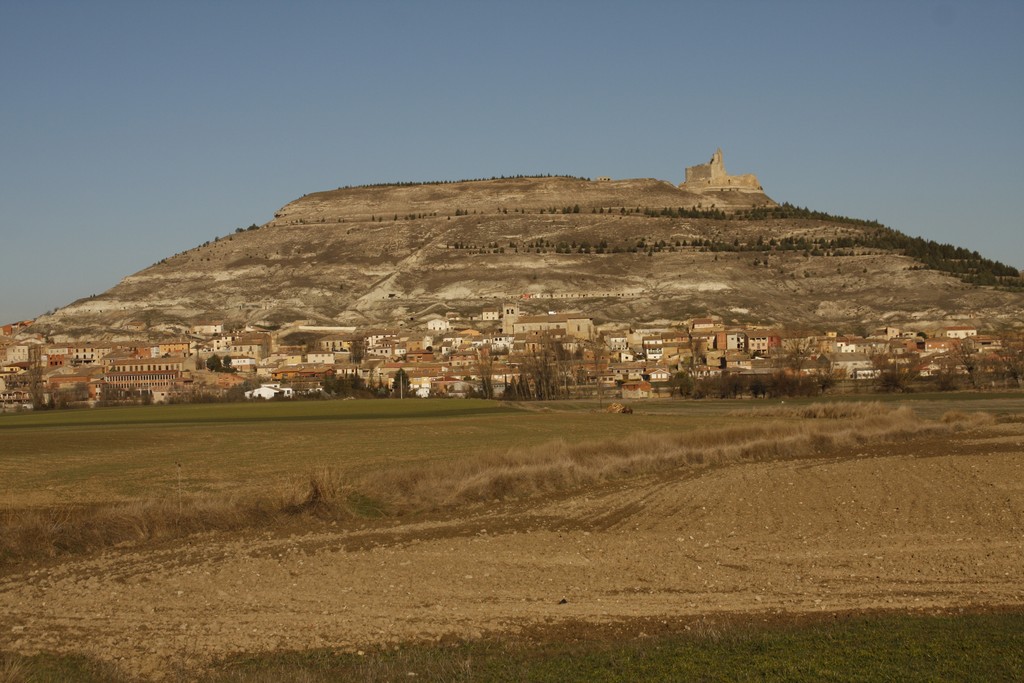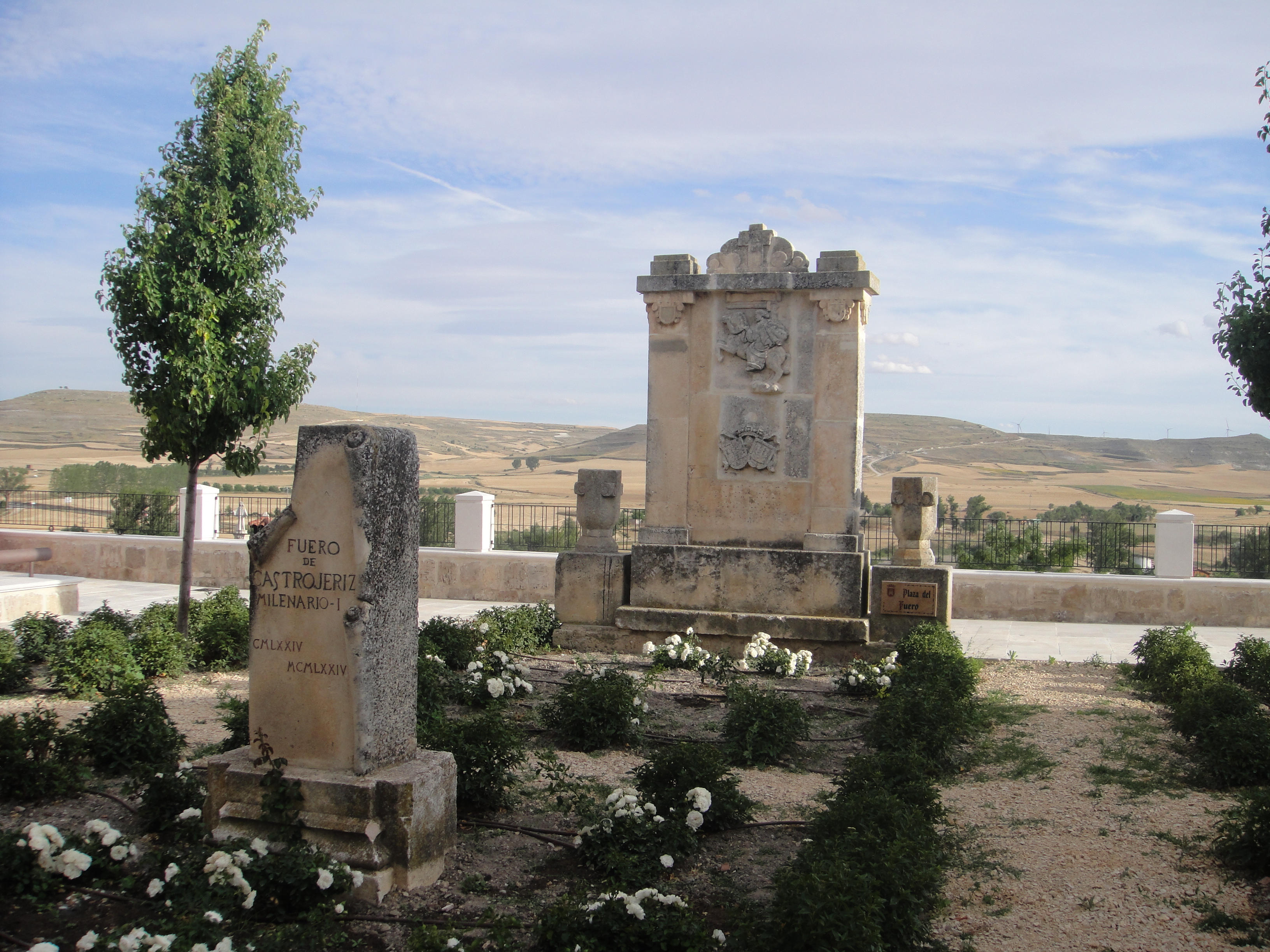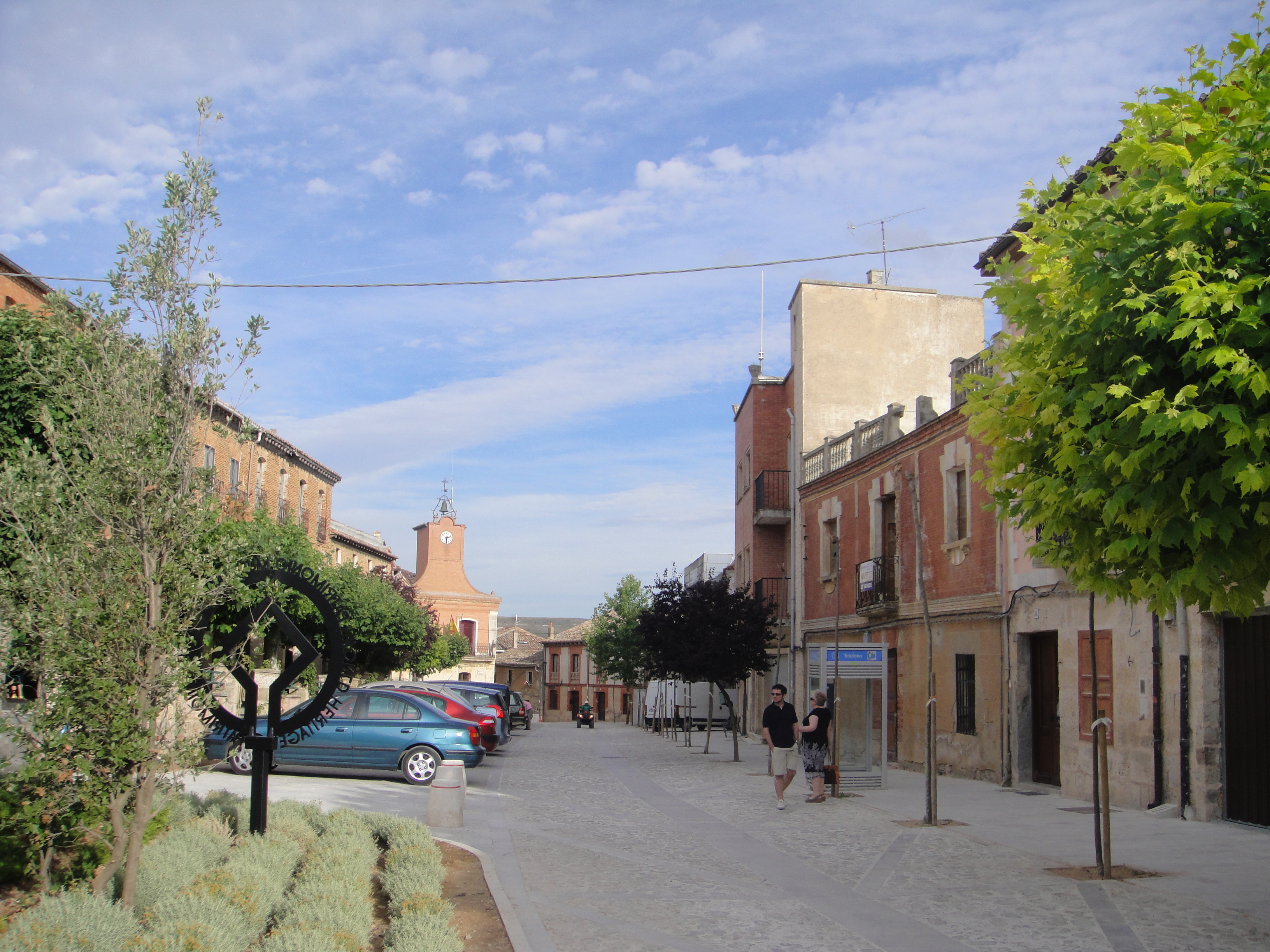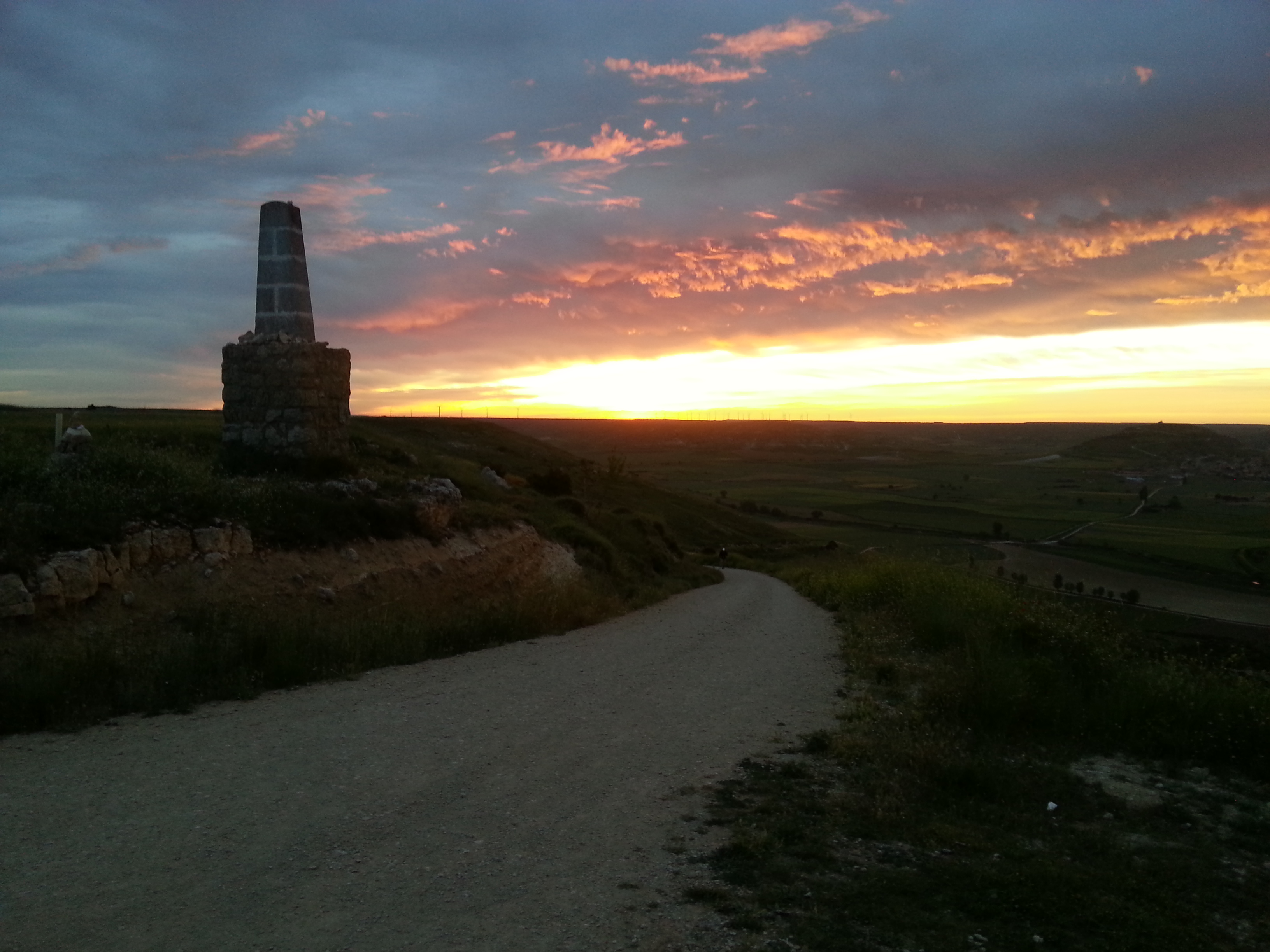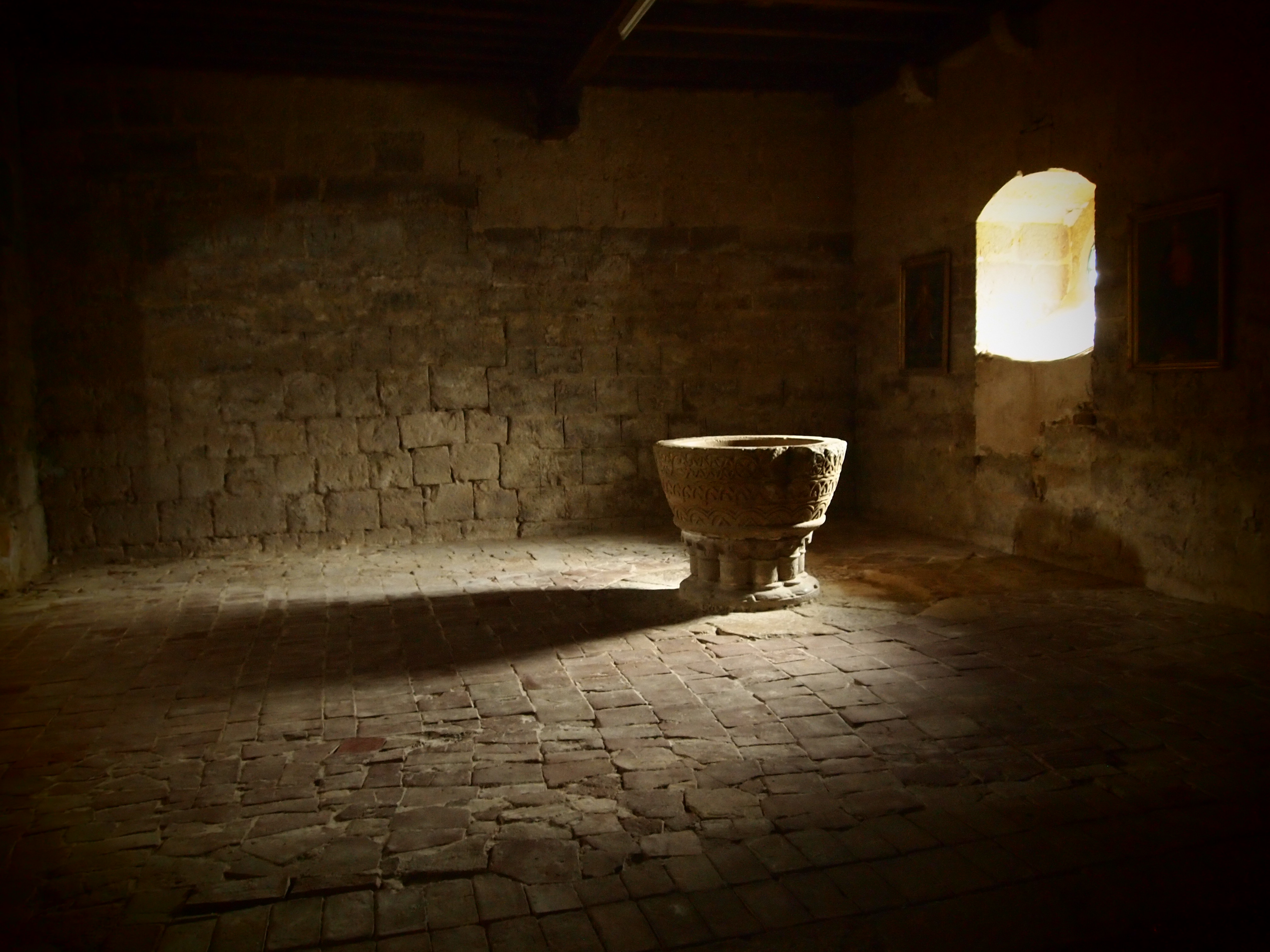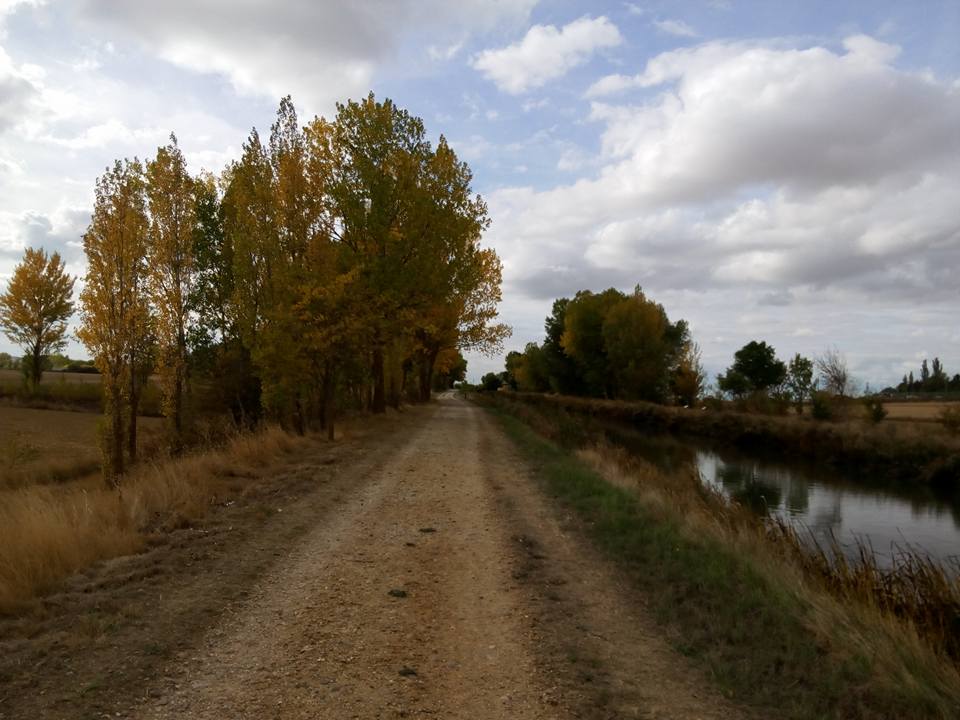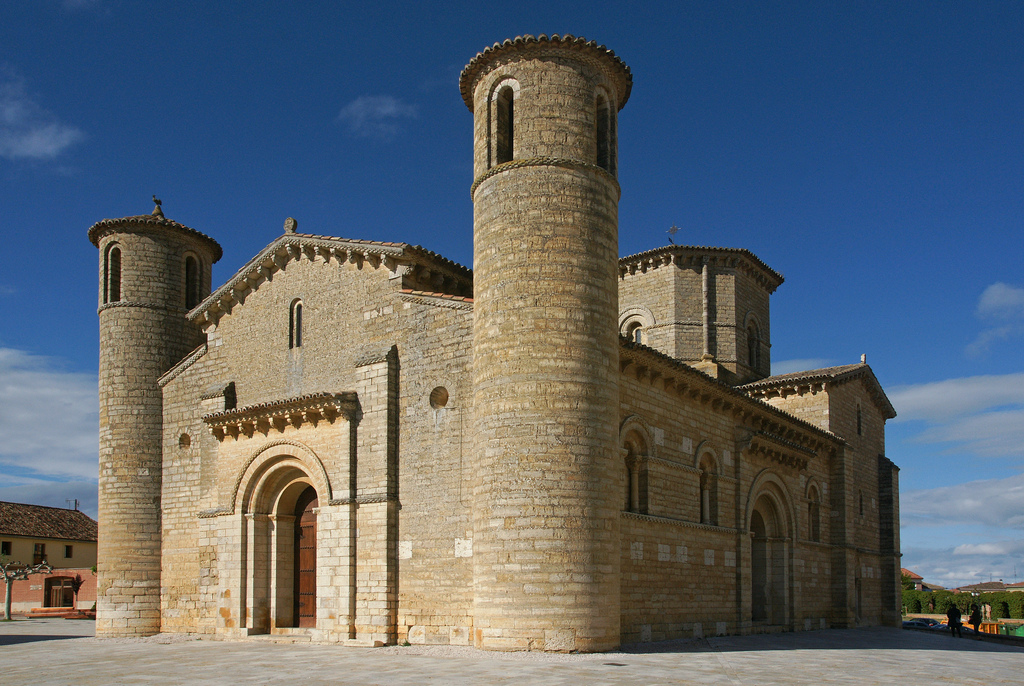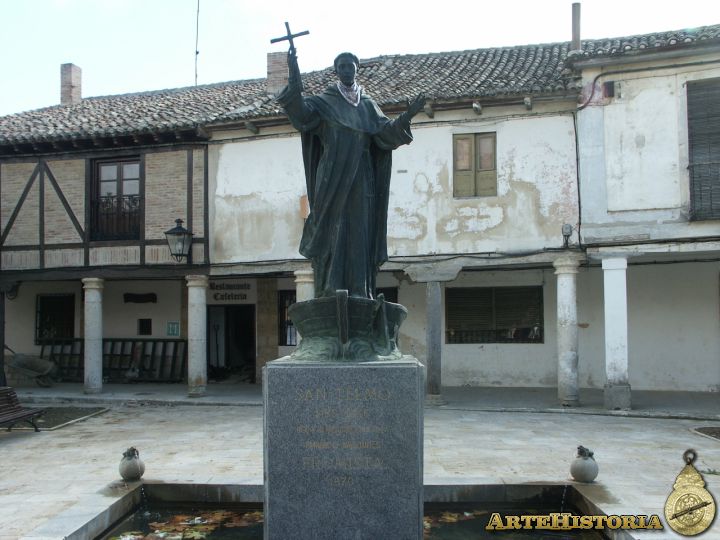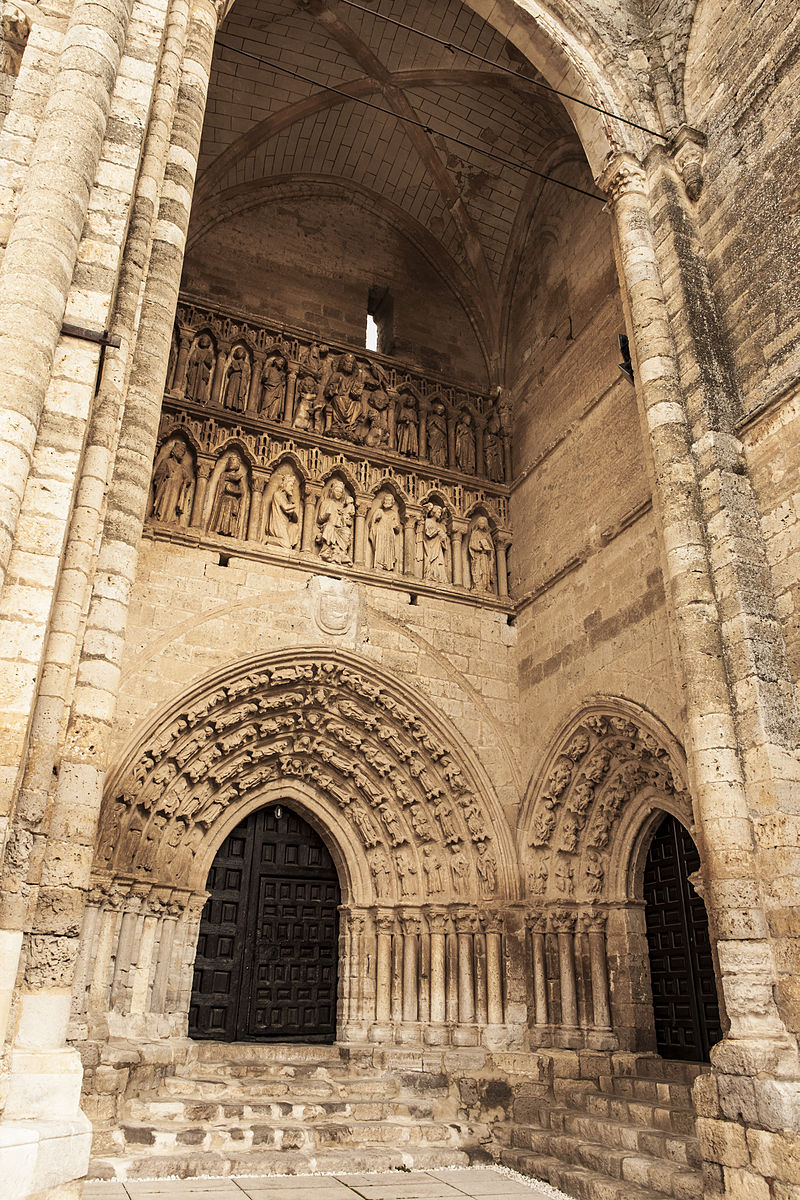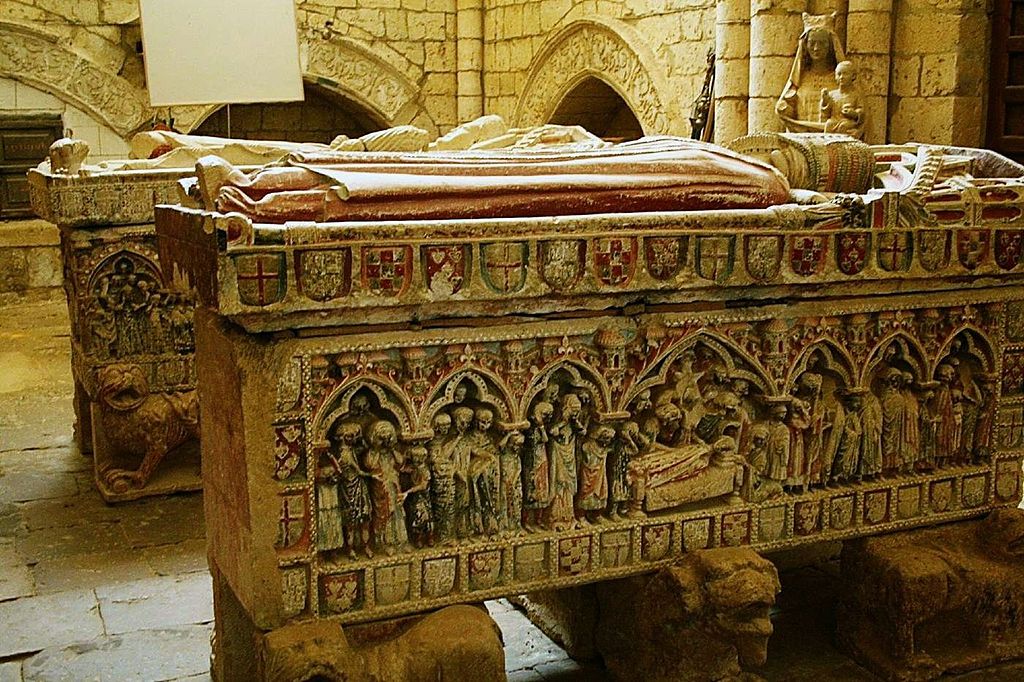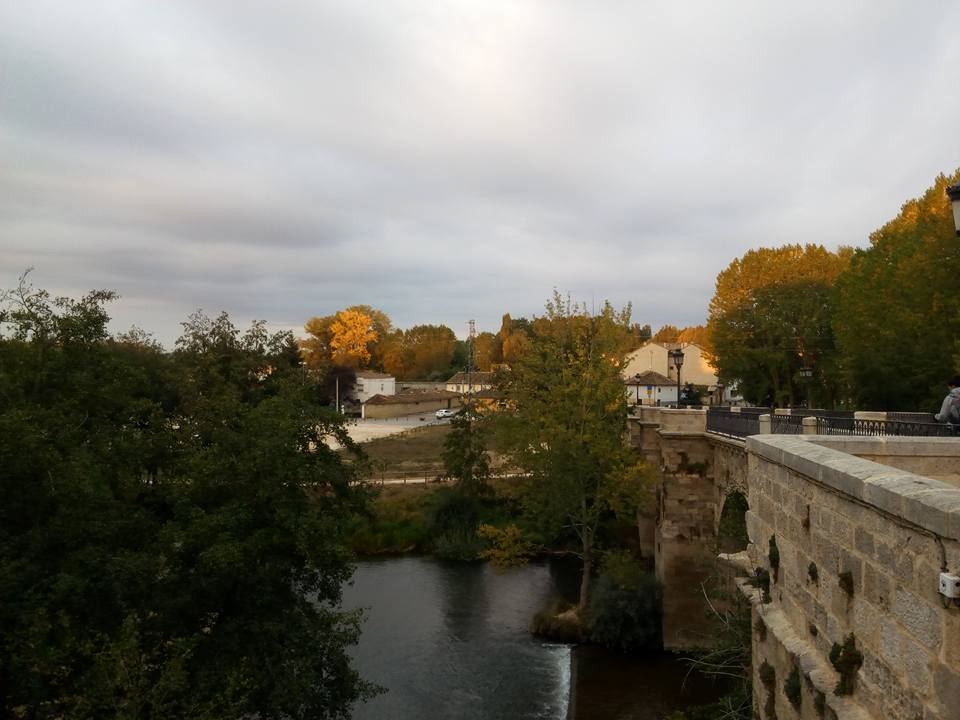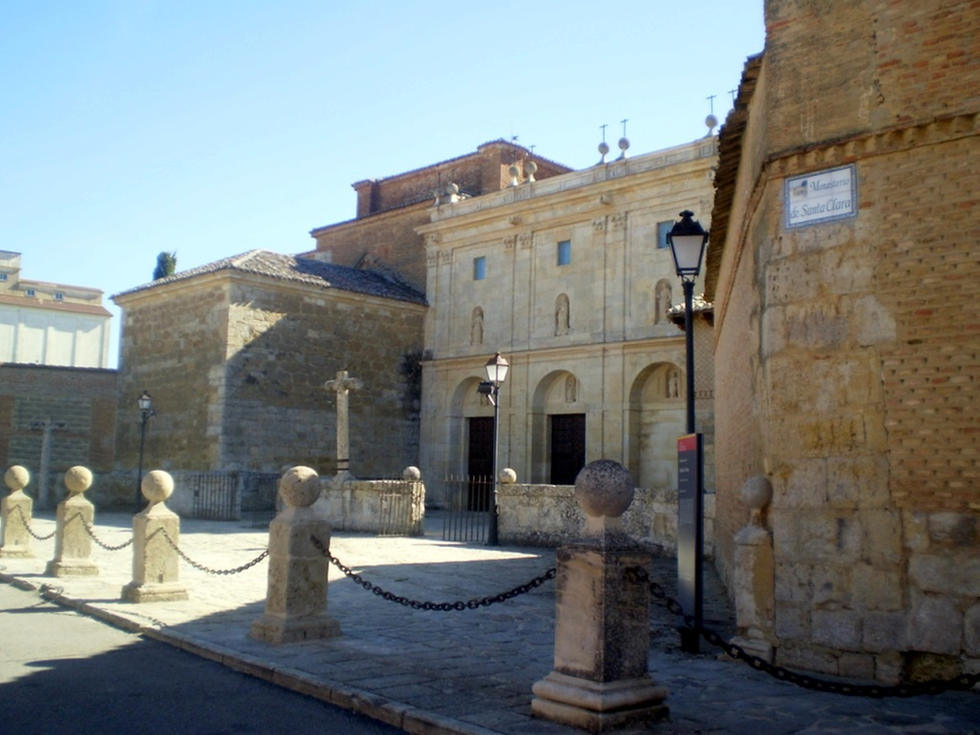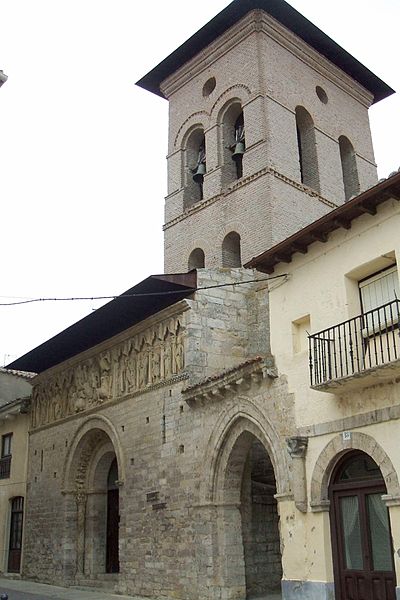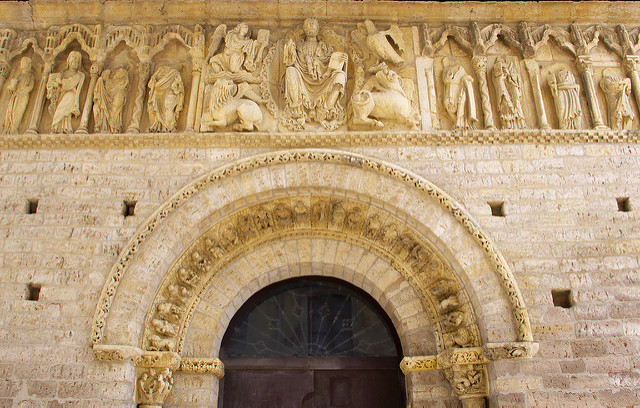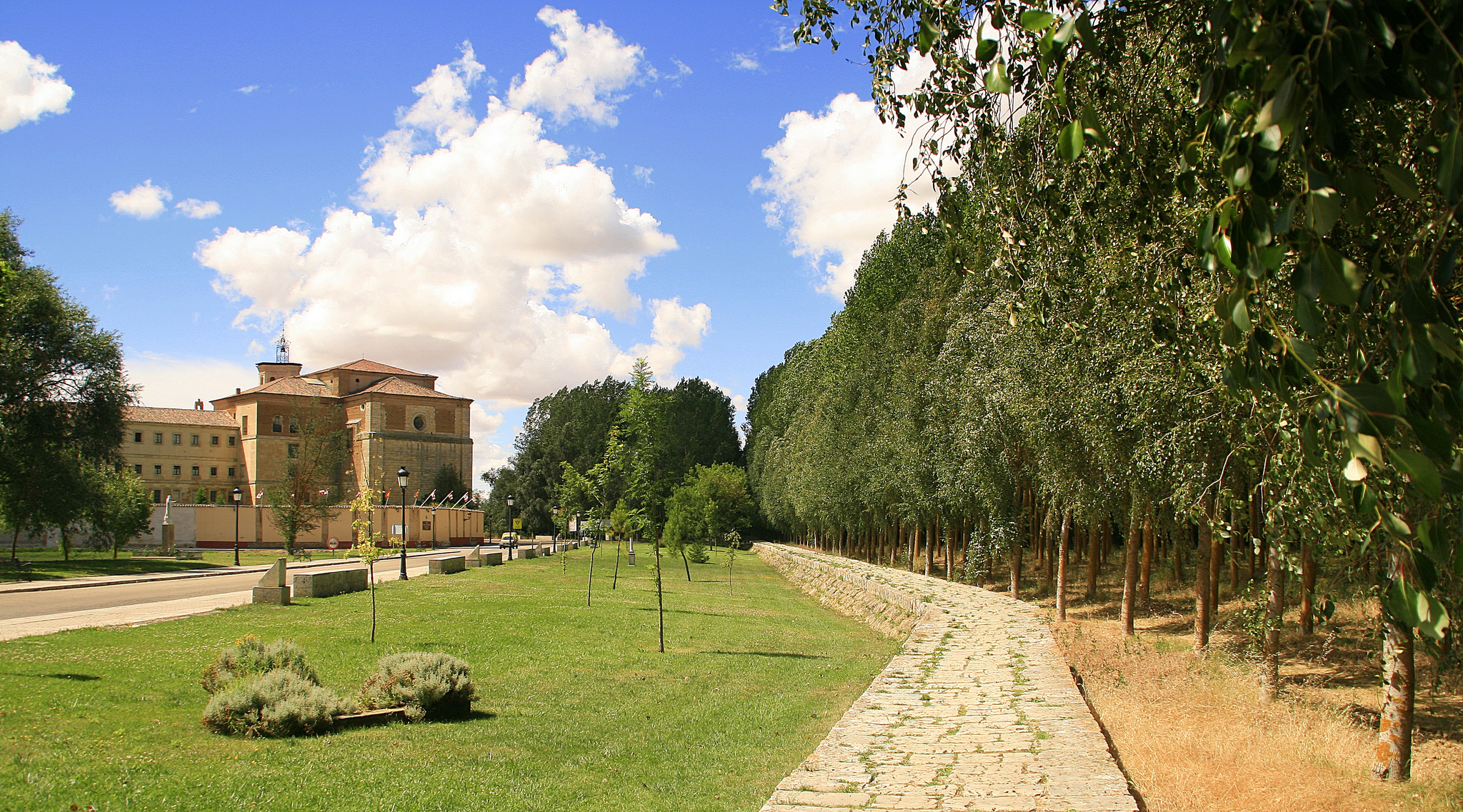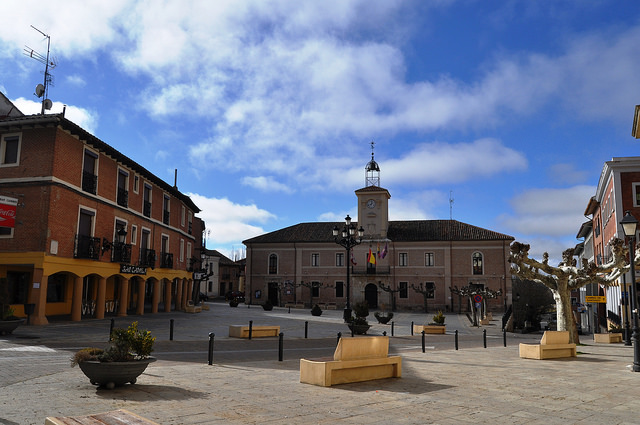STAGE 7: FROM BURGOS TO CARRIÓN DE LOS CONDES
Erea FabeiroFRENCH WAY BY BICYCLE
- Distance to Santiago: 487 km
- Stage distance: 86 km
- Estimated time: 6 – 6,5 hours
- Minimal height: 773 m
- Maximum height: 930 m
- Route Difficulty: Media
- Places of interest: Castrojeriz, Frómista, Villalcázar de Sirga, Carrión de los Condes
- Route Map: To see the route in Google Maps click here
At this stage we will cross completely the Burgos countryside to enter Palencia, part of the so-called “Tierra de Campos”. Our body and mind will have to become familiar to circulating between a much more homogeneous landscape than the previous one in which the relief, deeply leveled, will be broken by hills that will rise like statues in the horizon and that sometimes we’ll have to cross.
There are those who despise this French Way part and focus on crossing it as quickly as possible, dismissing what is seen as monotony without inducements. It is true that this part is hard – especially in summer – but it is also an essential of the pilgrimage part: The image of its fields is one of the most recognizable of the Way. Our eyes will follow for miles this print, a route in a straight line, flanked by golden fields among which stoic oaks will sometimes rise. Which is very possible that we seal in our retina and there will be a source of peace and tranquility for the future, reminding us the serenity of the pilgrimage, and the great opportunity it offers us to focus on ourselves?
Let us now forget the world in which the pre-eminence is immediacy, innovation and permanent changes. On the opposite, let the harmony and environment stillness encourage our introspection. Pilgrimage gives us time to think and not simplify what is complex, so remember Machado, Unamuno or Fernán González and find in Castile a world full of nuances, rich landscapes and humanity.
PROFILE AND STAGE’S MAIN ROUTES
This stage runs mostly through tracks of good ground between fields and, at the end, by asphalted county roads. Normally, the profile is much leveled and the height differences will be exceeded over long distances, so that the descents will be smooth and pleasant. The climbs will not be extremely hard.
There are only three points where we can have more complications with the profile:
- When arriving at Hornillos and Hontanas there are two toboggans descending to the town that are remarkable but also do not have much technical difficulty. It is necessary to keep on count that, especially in Hontanas, the elevation difference is such that the town is not seen until you almost have it ahead, which makes it psychologically hard because it seems that you pedal and don’t move forward.
- El Alto de Mostelares es otro punto de complicación, justo a la salida de Castrojeriz. is another point of complication, just outside of Castrojeriz. Here we must to go through a 140 m rise in just over 1 km, with an average relative slope of 11%. The descent is also vertiginous, in firm ground with loose small stones.
Actually, the greatest difficulties that this stage supposes are the mileage, and especially if we travel in summer, the wide distances without shade between populations and services. It is true that it is longer than the previous stages but also the plain helps to gain speed and the terrain is favorable.
To leave Burgos you have to cross the university campus of San Amaro where, after crossing the bridge over the Arlanzón, we can use the bike lane until the N-120 which turns left and the signal tells us to cross the pedestrian’s passage to Benito Pérez Galdós Street. At that point we have two options: cross and go the original way or skip it and go on the N-120 until Tardajos.
If we go by the traditional we will take the street Benito Perez Galdós. Turning on a dirt road until reaching the municipal area of Villalbilla de Burgos, where we will first cross the railroad tracks, then the BU600 for an overpass and then the A-231. The road then runs parallel to the N-120 until Tardajos.
In Tardajos, we already lose the N-120 and we will not find it again until Carrión de los Condes. Therefore, to visit the localities in this stage is necessary to go along the traditional way. Most of the time the firm will be land, although in some stretches the Camino de Santiago coincides with asphalted tracks or county roads.
Tardajos and Rabé de las Calzadas are joined by a tarmac track of 1.5 km. After crossing the village, it is necessary to cross 8 km to Hornillos Del Camino by a path between fields. It begins with a gentle but permanent ascent of 4 km until reaching a high (917 m of altitude) from which we can comfortably descend to Hornillos.
When arriving, we are 11 km ahead to Hontanas by another path in which the only place with services that is there is the hostel of San Bol, in a detour to the left to the 6 km. During this section we reached the maximum level of the stage (930 m).
The trail terminates on a 200 m slide where 50 m of difference of altitude is lowered to the Hontanas town center (kilometer 31 of stage).
From Hontanas it is about 10 km to Castrojeriz.. Los primeros 5 km requieren más dificultad técnica, ya que el sendero se encuentra en la ladera de una colina y hay piedras sueltas. Después, el camino de Santiago en este tramo coincide con una carretera comarcal que pasa por las ruinas del monasterio de San Antón y termina en Castrojeriz. Debido a la dificultad del primer tramo,The first 5 km require more technical difficulty, since the trail is on the side of a hill and there are loose stones. Afterwards, the Santiago road in this section coincides with a regional road that passes through the ruins of the San Antón Monastery and ends in Castrojeriz. Due to the first section difficulty, in Tournride we recommend – especially in times of influx of pilgrims – go by the regional road from Hontanas, when crossing the exit village.
After crossing Castrojeriz we head towards Itero de la Vega, from which we are separated 11 km. In the middle, stands the aforementioned Alto de Mostoles, in which we recommend compensating the climb hardness with the enjoyment of beautiful views offered and extreme caution in the descent.
Before arriving at Itero de la Vega, we crossed the Pisuerga River by a large stone bridge that marks the border between Burgos and Palencia. The original road immediately turns right by a dirt track to go to Itero and from there to Boadilla Del Camino but, if you prefer, you can continue straight on the P432 road to Boadilla (1 km less than the trail).
If you take the traditional way out of Itero de la Vega you will travel 8 km between fields to Boadilla Del Camino (kilometer 60 of stage): the first half in slight rise and the second in soft descent.
From Boadilla Del Camino there are only 5 km to Frómista, in a flat profile and along a path that runs along the Canal de Castilla southern bank. We cross the canal just before entering the town by a manual lock of S. XVIII and we arrive at the town center.
The road between Frómista and Carrión de los Condes is permanently parallel to the P-980 in the form of a gravel path, so we can choose to use it or go along the road. They are 20 km in which every 3,5 or 6 km there is a town: Population of Campos, Revenga de Campos, Villarmentero de Campos and Villalcázar de Sirga. The profile is slightly uphill the first 17 km and soft down at the end, although it is not very noticeable.
In Población de Campos, before crossing the river Ucieza Bridge, there is a detour that marks an alternative way until Villarmentero. It goes along the river north bank. If you are not going to go on the P-980 because you prefer the trails, this may be a good option for you. It is quieter and there are fewer pilgrims on foot.
In general, stage 7 from Burgos to Carrión de los Condes is long and characterized by tracks between cereal fields, joining populations separated by distances of between 5 and 11 km. The exception is the final part, between Frómista and Carrión de los Condes, more populated and by county road. The stage profile of the Camino de Santiago on bicycle has no complications except in the ascent and descent to Alto de Mostelares, where we must exercise extreme caution.
PRACTICAL TIPS
- Burgos is the center of a good number of communication routes, so if you start here your way you will have no problem getting there. We give you options:
- Bus: The station is here and every day there are connections with the Peninsula main cities. Some of the companies that have direct routes with the city are Alsa and Autobuses Jiménez.
- 2. Train: The station is here and directly or indirectly connects with the main Spanish cities. For more information you can consult the Renfe’s website.
- 3. Car: Burgos has very good connection with all the surrounding capitals and, from there, with the rest of the peninsula. If no acquaintance is encouraged to take you, you can always use platforms like Blablacar.
Although there is an airport in Burgos, in fact the Camino de Santiago border on its entrance into the city, as we saw in the previous stage, currently has no commercial flights.
Remember that in Tournride we leave the bikes for the Camino de Santiago in your lodging in Burgos if you start there and we can take your spare luggage so that it is waiting for you in your way end.
- Always be aware of the distances between populations, especially in summer. Eleven kilometers can be very long if we do not get enough water or food.
- Avoid pedaling during the summer in the central hours of the day as there are miles where there is no shade where you can get away from the sun. Always wear glasses, cap and sun cream.
DETAILED ITINERARY AND HISTORICAL-ARTISTIC HERITAGE
At this stage we will enter fully into the fields of Castilla. Its golden color will dye the way between visits to different towns that, many times, will have a heritage that will amaze us. We will discover small and friendly towns among others such as Castrojeriz, Frómista and Carrión de los Condes, who culturally have much to offer.
But in addition to these stops, we will find places on the road as impressive as the convent of San Anton ruins or the views that will offer us the peak of Alto de Mostelares.
SALIMOS DE BURGOS AND WE GO THROUGH FIELDS UNTIL “FALL” IN HONTANAS
In Tournride we know that the big cities outings can be a bit confusing for the pilgrims in bike, since sometimes the signals are a little hidden. In the itinerary map you have marked the route, but here we detail it better.
Putting as an exit point the municipal hostel, you have to follow Fernán González Street leaving the cathedral on your left. We arrived at the Arch of San Martin. This arch is shaped like a horseshoe and uses brick because it was built in the 14th century by Mudejar architects, that is, Christians who lived in Muslim territory.
AWhen crossing the Arch of San Martin, the arrows indicate that we go down the stairs to the left, but for us it is much better to go straight and turn 60 m later, avoiding the stairs. Take the Emperador street, which turns left into Villalón street and leads us to cross the Arlanzón. The stone bridge that allows us to get around the river is called “de malatos” (sick) because in the past there was a hospital for lepers.
After passing it we enter the area of the Parral Park and the University campus.. Although the arrows indicate the park central path, for us it is much more comfortable to go by the bike path that runs alongside the N-120.We can follow it for 1.5 km, drawing in three roundabouts in a straight line.
When the N120 turns to the left, we are shown the crossing of the zebra crossing to the right to continue along Benito Pérez Galdós street. Although it is not to follow the traditional route, know that the N-120 will take you direct to Tardajos,, the first stage population. The distance to travel is the same (7.5 km), but without crosses or detours.
If you prefer to go along the original route, follow Galdós street until it becomes a path that alternates with dirt and asphalt and leads you to cross the railroad tracks, the BU600 road and the dual carriageway. The final stretch coincides with the N-120 and leaves you in Tardajos.
Tardajos and Rabé de las Calzadas are joined by a paved track of only 1.5 km long. Both places have Roman past and, in fact, were located in a strategic point in which different roads converged, including the “Fifth Way” that united Clunia – in the south of Burgos – with Sahagún. The name of Rabé “de los Calzadas” comes from there.
The river Urbel runs vertically between the two towns and in the Middle Ages used to flood constantly. This was very unimportant all the way between both localities, which affected the communication and ended up establishing the following saying: “From Rabé to Tardajos, you will not lack works; From Tardajos to Rabé, free Dómine.”. Do not worry; nowadays the road is much easier!
Rabé de los Calzadas reached a greater splendor than Tardajos in the Middle Ages, although Tardajos also had a hospital for pilgrims. Of the castle and the three churches that were there, today is very little and the place most remarkable is the palace of Villariezo, which we see at the town entrance, of S. XVII.
From Rabé to Hornillos there are 8 km that we must walk along a dirt path between fields.. The first half is in permanent climb and, when arriving at the top, we will see a slope of descent until Hornillos, which is in a valley. For the pilgrims on foot the descent is hard, since loading with weight becomes long – in fact this section is called “Matamulos” -, but in bicycle this Santiago road section has no difficulty.
We arrived at our 21 kilometer stage, Hornillos del Camino, with a prototypical Jacobean urbanism. Its main street coincides with the French Way and runs exactly from east to west. Today it has all the services and, as is usual in this type of localities, its church stands out in height and size among the small houses of two floors. Formerly it had a hospital for pilgrims that was founded in the S. XII by the king. Subsequently, the monarch gave the whole town to a French Benedictine monastery.
Leaving Hornillos we have to drive for 11 km along a path between fields, on a slight vertical slope for the first 4 km and then practically flat when arriving at the valley of San Bol. At 6 km, there is a detour signposted to the left to Go to the shelter and hostel of San Bol. Given the desert of this moor, this is an important place for pilgrims on foot, who often leave from Burgos and are already exhausted at this point so they need a place where take refuge.
Hontanas is at a lower level, so from afar you cannot see on the horizon. When we arrive, a 200 meter slide will leave us in the village center. The locality top toponymy comes from the old springs (“fontanas”) that there was in the place and that became an oasis of peace for the medieval pilgrims, after crossing the previous paramo without shadow. Today it has all the services that modern walkers may need.
Before going down to the village, to our right we will see a picnic area next to a small hermitage. The place keeps an image of Santa Brígida, a Swedish woman born in a family of high birth at the beginning of S. XIV that had religious visions from small and that peregrinated to Santiago de Compostela, in addition to other destinations like Holy Lands.
Already in the village, we will be struck by the church that is in the center,, with a tower that surpasses in height to the rest of constructions. The temple is dedicated to the Immaculate Conception and has Gothic origin (S. XIV), although it was later rehabilitated in the S. XVIII, reason why it has neoclassical appearance. This can be seen, for example, in the use of classic elements to decorate the tower: semicircular arches and pediments (triangle shaped trimmings).
WE PERCEIVE THE SAN ANTÓN MAGIC CONVENT AND ARRIVE TO CASTROJERIZ, LAST BURGALES
At the exit of Hontanas the arrows indicate the road crossing to take a path that follows by the slope of a hill and that in 4 km returns us back to the road. Since the trail is narrow and does not have any type of safety wall to avoid the fall by the hill, we recommend obviating the arrows to the exit of Hontanas and instead of crossing the road continuing by her directly until Castrojeriz. Of course, caution because it is a narrow road and double meaning that, in the end, we should also share with the pilgrims on foot.
Six and a half kilometers after leaving Hontanas we will see the impressive San Anton monastery ruins. In Tournride we recommend you stop to enter the monastery, as it is one of those enigmatic and the French way spiritual places.
The first thing that strikes you is that the road itself passes under an imposing portico formed by two large arched ogival arches that frame the old church north portal. The flaring cover has 6 archivolts full of sculptures, which are surprising because of their good state of preservation. To the right, in cover front, there are two niches on the wall. These holes were actually cupboards and were used by the monks to leave bread and wine to the pilgrims, since this place was focused from its foundation to the walker’s attention.

The convent was founded in the 12th century, although the remains we see today are Gothic (S. XIV), hence the pointed arch use.. In the Peninsula was a very important center of San Antonio Order until in the S. XVIII the king Carlos III delegated its management to the private scope. Since the confiscation of Mendizábal in the 19th century, the place was abandoned and since then began its decline, although the good ashlarry with which it was made allowed it not to collapse at all. In 2002 began a rehabilitation project for the attention of pilgrims and today it is possible to sleep there, being the pilgrim’s fundamental principles the same as the Antonines followed a thousand years ago: gratuity and austerity.
If you skirt the building you can enter the church, today without a roof, on the south side. Looking at the structure we can distinguish the organization that had in three ships. The apse wall is quite well preserved, with large buttresses attached to the windows.
In this church, besides the attention to the pilgrim, one of the practices that gave reason to be to the Antonines’s order was carried out: the illness cure “Ignis Sacer”. This evil was also known as “sacred fire” and was a widespread disease in the Middle Ages: it caused the loss of extremities after suffering very strong pains. Today it is known that the disease was caused by a fungus that parasitized rye, hence it was so common, since it was one of the population’s main foods. Curiously, the Antonine monks were able to discover the origin and cure of this disease centuries before science succeeded, using wheat and plants.. They secretly kept this information and, therefore, were the only ones who were able to cure it. So much so that Ignis Sacer came to be known as the “St. Anthony fire” and, in fact, many sick of this evil pilgrims to Santiago just to pass through this monastery and heal itself.
After this visit we continue along the road to Castrojeriz, which we will see in the distance occupying the hillside lower part, on the top of which there is an old castle. This is a good place to stop: it is almost in the middle of the stage (41 km), has all the services and is one of the most beautiful places we will visit today.
This town is, after Burgos, the second largest Burgundian town on the French Way and the last one we will spend in this province.. Historically has had much importance and the hill top where it is has archaeological remains that date from the 1500 a. C as well as Romans and Visigoths – these last inhabitants already made a castle there.
Anyway, when really began to gain transcendence was after the Repoblation.. After two Arab attacks in the 8th and 9th centuries that destroyed the Christian fortresses there, this place is conquered and becomes a strategic place to control the entire territory to the Douro. Therefore, it was vital to repopulate the area.
For this reason, Castrojeriz was given one of the Castile’s most important charters, which today constitutes an interesting sociological document. In the previous stage we saw how in Burgos a privilege was given by which the person who broke the land first was left in property – which gave the category of free peasant. Here the peasants were given the opportunity to become a kind of “second nobility”. All they had to do was get a horse and go to war with him, becoming gentlemen. They were called “caballeria villana” or “infanzonía”, and this meant access to a series of legal and fiscal privileges.
In a society as hierarchical as the medieval one, the fact that these privileges were promulgated is a tension sign that must have taken place centuries of struggle between Christians and Arabs. It also makes one think of the level of violence that should have been established socially if any peasant who took a horse was considered valid to fight.
Nowadays, Castrojeriz is a town with much to offer. The first thing that we find on arriving, before the hill, is a splendid church with a large rosette on its western facade.
It is the former collegiate church of Santa María del Manzano. It began to be built in the 13th century, Romanesque, but in the XV its roofs were changed by other Gothic and in the XVII the temple was expanded. Inside, there is a Gothic carving of the Virgin and legend says it was found inside the trunk of a large apple tree in Castrojeriz.. There was a hermitage that was enlarged to become the temple we see today, where the sculpture became famous for performing miracles. He was so well known that Alfonso X “the Wise”, narrated some of them in his “cantigas” (poems) dedicated to the Virgin.
The streets in Castrojeriz are arranged parallel, in the hillside of the hill and are united perpendicularly by stairs. For this reason, we recommend that cyclists follow the large pedestrian thoroughfare that will pass through most of the relevant buildings.
You will first see the church of Santo Domingo -the temple is Gothic, although it does not look like it by its Plateresque tower of S. XVI -, later by the long and porticada Plaza Mayor and, at the end, the church of San Juan.
The church of San Juan deserves a stop to see the interior. This temple was designed by one of the most important architects of the 16th century German Gothic, named Rodrigo Gil de Hontañón. He also participated in the design, for example, the Salamanca Cathedral Segovia or Plasencia. If you can, we recommend that you enter the church to take a look at the impressive ribbed vaults that cover the space at the same height in the three naves. The columns do not have capital and of their columns they leave nerves that extend by the roof like branches of trees in perfect symmetry. All a work of art!
A BOADILLA DEL CAMINO: WE CROSSED THE TOP OF MOSTELARES AND ENTERED PALENCIA
With this precious image we leave Castrojeriz and, on the way out, we are faced with the vision of Alto de Mostelares. From the town exit until we almost reach the river Pisuerga, the firm will be of land plagued by small stones in some moments.
After crossing the Odrilla River by a wooden bridge, we began the ascent. On average the slope is 12%, to which can be added the wind action and the intense sun heat. Intense but short.
We cross the plain at the top and, almost immediately, begins the descent. We advise caution since in a little more than 1,5 km are lowered about 115 m; Although it is facilitated because part of it was recently paved.
We continue along the trail for 3 km, completely flanked by the Burgos countryside. The road ends in a regional road and in about 900 meters we see a detour to our left to take the path that takes us to Puente de Itero.
Before arriving at the bridge we will see a construction on our right: it is one of the French Way most special shelters.It is the old hermitage of San Nicolás de Puente Fitero, which was abandoned for more than two centuries until an Italian professor decided to promote his rehabilitation as a hostel. Here the dinner is communal and every night there is a ritual washing of feet to the pilgrims who stay there. This tradition was common among monks in the Middle Ages. Mystical and spiritual place that will provide an experience not to forget.
The bridge of Itero (or Puente Fitero) is one of the longest in the French Way and under its 11 arcades runs the Pisuerga, natural border between Burgos and Palencia.. It was built in the 11th century and in the 17th century it was restored respecting its original shape, with high quality ashlar masonry.
After passing the bridge the road marks to the right, towards Itero de la Vega. “Itero” comes from the Latin “petra ficta” that evolved to “milestone” or landmark (road delimiter). This expresses its border position on the Pisuerga riverside (“vega”) and is that, when leaving the town, we will fully enter Palencia and its natural region called “Tierra de Campos”..
This natural area Palencia also shares it with Valladolid, Zamora and León. Together, they produce a volume of cereals so high that they are called the “Barn of Spain”. Of this we will give good account ourselves, since up to Leon we have in front of miles of pedaled by trails of earth between hectares plagued of golden cereal.
After crossing 8 km we arrive at Boadilla (kilometer 60 of stage). In this small town we will find all the services that we need. In the town center there is a kind of stone column that is, in fact, a jurisdictional roll.
These columns were placed in the villages to indicate the administrative category that had the population and to differentiate it from the rest. They could only be placed where there was a mayor and, therefore, where he had the power to condemn to death. In fact, on the roll the convicts were tied with chains to expose them publicly before judging them. In this case, this scroll is from the 16th century and indicates the neighbor Castrojeriz people independence.
The jurisdictional roll of Boadilla Del Camino stands out for its height and decoration, being one of the most important in Spain.. Although there were many, few of them are conserved, because the Constitution of Cadiz (1812) had ordered to destroy them all. These columns were political symbols and judicial power of a lord in a territory and the new law abolished these powers.. For that reason, only rolls remain in the places that they refused to demolish them.
Behind the scroll we see the Our Lady of the Assumption church. Although the temple origin is Romanesque what we see today is S. XV and XVI – this century stands out its main altarpiece. Of its beginnings yes a large baptismal font is stored and profusely decorated.
THE CASTILLA CHANNEL TAKES US TO FRÓMISTA
After leaving Boadilla del Camino on the main street, an arrow indicates that we turn left. In a little more than 1 km, we arrive to the Channel of Castile bank, by which we will travel 3.2 km in plane until a lock by which we must cross the channel and to enter in Frómista.
This channel was one of the most important engineering projects carried out in Spain during the Enlightenment.. It was promoted by Ferdinand VI (1713-1759), a king influenced by this cultural and intellectual current and carried out along with his minister the Marquis de la Ensenada. The idea was to give way to all the surplus of cereal that was produced in Castile, since the communications of this area with the peninsula rest were harmful and one wanted to revitalize its economy.
It was intended to unite Segovia with the Cantabrian Sea in Santander, but this was an enlightened dream. Despite this, 207 km of canal were made in which barges with products circulated by horses. It became a very important engine for the Castilian economy, its first sign of industrialization; although with the railroad appearance lost this use. Today it is obtained from it hydraulic energy, is used for irrigation and also has recreational use (fishing, tourism, etc.)
The road will become a pleasant walk that, after crossing the lock that allowed saving 14 meters of unevenness of land, will leave us in Frómista. In the lock there are stairs, so you can cross the bridge of the road that is a little further on.
The “Camino” way crosses Frómista on the lower side, so if you want to visit some of its monuments we will have to turn right when you get to its great central avenue (Ingeniero Rivera Avenue)..
Frómista is one of the best-known Jacobean locales. Despite having less than 1000 inhabitants, it has a great cultural, historical and gastronomic heritage. The place is also known as “villa del miracle”, referring to a legend of a man who was excommunicated for not returning a loan to a Jew. It turned out that, even though he had returned the money, when years later he died and tried to receive extreme unction, the priest could not do so because the metal cylinder with which he was to anoint him remained stuck to the paten. Until the misunderstanding was clear, he could not receive the last sacrament.
But … what does Frómista offer to visit it today? First is the important monument, the church of San Martín.. The temple image always comes to mind when speaking of the Romanesque style, as it is one of the exponents of this style. It is dated between the end of the C.XI and the beginning of the C.XII. In the XIX century it was object of a great restoration

This church transmits a lot of beauty for the simplicity and cleanness of its forms, which play with the volumes in a very balanced way.. It is of three naves with semicircular apse and vault of cannon – the most common medieval form – but it surprises with its octagonal dome with lantern and with the two western facade circular towers. It is normal that the towers were quadrangular, so this is reminiscent of Carolingian or German art.
In addition, the San Martin temple conserves a great amount of decorative sculpture, very rich in details. In each “canecillo” – in the eaves of the roofs – there is a small sculpture and outside moldings check marks all the buildings heights. Inside, the decoration of its capitals is surprising.
In addition to the church of San Martin, in Frómista also is the temple of San Pedro, in the place of Tuy.. This is not Romanesque, but Gothic, which can be seen in its vaulted vaults. Its cover is Renaissance and part of the temple is occupied by the local parish museum.
In the same great avenue of the town, is the sculpture of the Patron Saint of Frómista: San Telmo. This saint was born here in the 12th century and toured Asturias and Galicia preaching, especially with fishermen – that is why in this sculpture in the middle of the Castilian plateau is represented in a boat.
FROM FROMISTA TO VILLALCÁZAR DE SIRGA AND LAST KILOMETERS UP TO CARRIÓN
At the exit of Frómista we have to cross two roundabouts on the P-980 and then the indications are simple: continue straight along the road to Carrion de los Condes. The path for pilgrims on foot is permanently parallel to the asphalt, with two cairns in the middle each, hundreds of meters.
Even though the trail is quite wide, it will be more comfortable for us to go down the road. They are about 20 km in profile of very high elevation, although the feeling will be almost to go flat.
. As in Tournride we know that after all the effort made today you will already be tired, we are going to give you some slight notes of things that can be interesting in case you want to stop.
The first population is, worth the redundancy, Población de Campos. In it we can find all the services that we need. Although in the past it was closely related to the Order of St. John today the most remarkable are its two hermitages and its parish church dedicated to St. Magdalene.
Before crossing the river Ucieza by a bridge, at the exit of Población de Campos, there is a marked detour to the right. It is an alternative route that we can take if we want to go between fields to Villovieco.. There we will cross the river again to take the P-980. The distance is practically the same for the two roads.
If we go by the P-980 instead of by the alternative road we will pass by Revenga de Campos. In the tower of the church of this population they usually nest the storks, bird that in Castile finds one of its better habitats in the Peninsula.
Wherever we go, the road will pass through Villarmentero de Campos. The church of San Martín de Tours stands out. Although it does not attract much attention on the outside, it has a beautiful Mudejar coffered ceiling: the Muslims who lived in this Christian territory created a beautiful wooden deck here.

Finally, the road passes through Villalcázar de Sirga before arriving at Carrion de los Condes. Of the four towns of this last section, Villalcázar de Sirga is the one that has a more remarkable patrimony, largely because it houses the church of Santa Maria la Blanca.
As soon as it is seen from afar the temple surprises its size and robustness while, on the inside, it marvels at its delicacy. The church began to be built in the 12th century and was closely linked to the Order of the Templars and the Crown. In fact, to the Virgin White that adores there dedicated Alfonso X the Sage twelve of his “cantigas”.
When the Order of the Temple was dissolved in 1312, the temple was ceded to a family of high birth. The dissolution of this organization has passed into history full of legends, given the abruptness of its eradication. The truth is that since its birth in 1118 the Templars had accumulated so much power that even Philip IV, king of France, owed them an immense amount of money. For this reason, he imprisoned some of these knights and killed them after torturing them, also pressing the Pope to dissolve the order, which he achieved in 1312.
If you can enter the interior of the church, take a look at its main altarpiece and the polychrome sepulchers full of reliefs, you will not regret it!
After this last visit, we walked the last 7 km of stage along the P-980 and we entered Carrión de los Condes by the Pilgrims. You just have to enjoy a well-deserved rest!
A LATE RIDE BY CARRION DE LOS CONDES
Carrion de los Condes is one of those places that, although it is not of great size nor it concentrates a great number of inhabitants – it counts on near 2000 -, yes it has a long historical trajectory carved in monumental patrimony. It lost much of its monuments during the War of Independence, but still keeps a lot of treasures that are worth discovering.
In Tournride we encourage you to enjoy a walk around this locality. Its size and the concentration of places to visit allow, in just 30 minutes, you can make a general picture. To facilitate the experience, we have prepared this itinerary map and give you some small notes on what to see in Carrión de los Condes.
Encourage you to walk, you will not regret it!
Carrion de los Condes, from legends of Trojan horses to a modern cultural city
In Tournride we think that in order to appreciate what we visit today it is necessary to understand how it came to be generated. Therefore, we begin this walk giving a few brushstrokes about where Carrión de los Condes is and what has been his historical development.
Carrión de los Condes is in the center of the province of Palencia. Its privileged position on the banks of the river Carrión, in the arid plateau of Castile, has made it inhabited since prehistoric times. Even so, the first urbanized settlement is believed to have been Celtiberian.
In the S. I a. C. the Romans arrived at the place and destroyed with what there was, creating a new settlement that, when it fell the empire in the West in S. V, the visigodos took under their control. In the northwest part of the right bank of the river Carrión they constructed a castle, of which today there are no remains.
The Arabs are made in the S.VIII with that fortress, denominating Monte Algiers. From the attempt of an Asturian knight from the time of Alfonso II “El Casto” to recover the citadel of Arab hands arises one of the most famous legends of the town that, despite being very ingenious, was not precisely “innovative” historically speaking.
In the “Iliad” Homer tells how the Achaean army managed to penetrate Troy after years of siege. It is said that the Greeks simulated leaving in retreat, leaving a hollow horse at the gates of the city, which the Trojans took for an offering from Athena and into Troy. At night, the Greek warriors hiding inside the horse opened the gates of the wall and their army devastated the city.
In this case, Christians are said to have used chariots instead of a horse as in Troy to recover the castle of Mount Argel. They put arms in the coal and disguised themselves as coalmen, pretending to the Arabs who only wanted to enter the castle to sell their merchandise. When they entered, they opened fire, and when they fled the castle they fell into the ambush of the Christian army, waiting for them at the gates.

Thanks to this ingenious tactic, the castle returned to Christian hands and, around this point began to develop the population nucleus, which came to have great importance in the Middle Ages. It was established as a “county”, that is to say, a territory governed by a count dependent on the royal family. The royal visits gave great importance to the town and many families of high lineage were concentrated there.
In fact, the name of “the Counts” comes because there were different power struggles between families to control the place and, in the S. XV, three families of different counts signed a pact not to lose the power before another county family. Carrión will be a county until it changes the territorial organization and it becomes a municipality, already in the Modern Age.
The splendor of the Middle Ages was reflected in the construction of a large number of buildings of great artistic value, both civil and religious. There many religious orders were concentrated in monasteries – a large part of the lineage of the families of Carrión happened to direct them – and the upper class constructed houses of stone emblazoned. In addition, Carrión had great commercial importance and was a mandatory stop on the French Way, so there was a great flow of goods and people there. So much so that there were 15 hospitals of sick and pilgrims and by the end of S. XV had 6000 inhabitants..
In addition to all this, from the S. XI Carrión also had gained fame because a family of infants took to a monastery of the locality relics of important Roman saints. Among them, San Zoilo, who was a martyr decapitated in Cordoba for preaching in the S. IV, when Christianity was still persecuted.
In the sixteenth century the plan of the city was already similar to what we see now, but a recession caused by the plague and the excessive taxes qthat were applied in the locality, which reduced trade, began to break through. In addition, the pilgrimage no longer had the flow of previous centuries. Some 600 inhabitants were reached, but thanks to the establishment of a “free” weekly market (free of taxes) by royal order the commerce began to re-emerge and, with it, the life in Carrión. In the S. XVII was even to trade with Flanders or France and in the following century the situation remained stable.
In the S. XIX takes place one of the most tragic episodes of the town. With the Napoleonic occupation in Spain the War of Independence is unleashed and Carrión de los Condes becomes the scene of the confrontation. The leader of the Castilian resistance decides to burn all the important buildings of Carrión o avoid that the French could get to take his power and to take shelter in them. Convents and churches were burned and, very importantly, all the archives that kept historical documents of Carrión de los Condes..
This fire, added to the confiscation – which emptied all the masculine convents of the city -, much changed the urbanism. Some of the buildings burned or abandoned were used to build new ones, such as the Town Hall or the Market Square. “Carrión de los Condes” was modernized during that century and the next, finally becoming the attractive locality that it is today.
We start walking and, for a change … we do it from east to west! From the convent of Santa Clara to the interesting cover of the church of Santiago
We leave the southeast part of Carrión, near where we enter from the P-980. There is the Real Monasterio de Santa Clara (Royal monastery of Santa Clara), our first stop.
Santa Clara was Italian and was the first woman to write a monastic rule for women in the 13th century. Two direct disciples of Santa Clara founded this convent in the year 1231, which makes it one of the oldest in Spain.. In addition, it occupies a great extension of land and its operation has been almost uninterrupted.
Architecturally, little remains of the original building of S. XIII. What we see today is the overlap of reforms, the most important of the S. XVII, which was when the monastery reached its moment of splendor during the management of Sor Luisa de la Ascensión. This abbess was able to accumulate a great influence. In fact, it was the one that got the king to create a tax-free fair to re-circulate goods after the recession of the sixteenth century.
It is said that the monastery survived in good condition to the War of Independence thanks to the cunning of the nuns, who made a pact with the French for which they invited them every afternoon to a chocolate if they respected the place. Whether it is true or not, the monastery spent the war intact and, in fact, the nuns who live there today continue to prepare typical sweets.
The convent today houses a museum, highlighting among its assets the impressive collection of nativity scenes of the world: figures representing the birth of Jesus brought from all over the globe. It is also worth visiting the church, with its altarpiece presided over by a sculpture of Santa Clara.
At the north gate there is a well. As many Jacobean walkers drank of it, it is called the well “of the Pilgrims” or “of Health”. It was considered that this spring was exactly in the middle of the Way of Santiago from France, although today it is thought that this point is a little later, passed Sahagún.
Following the street of Santa Clara and crossing the road, we passed the tourist information booth and arrived at the church of Santa María del Camino.. In this 12th century temple, of great dimensions to be Romanesque, a pilgrim’s Blessing Mass is celebrated every day in the afternoon.
Following the pedestrian street, dotted with hospitality and shops – many of them specialized in the needs of pilgrims – we reach the Plaza Mayor. This will be the place where we will finish our walk, but first, we will continue the visit to the church-museum of Santiago, which is in the same pedestrian and is part of the most important heritage of Carrion de los Condes. We will stop, mainly, in its magnificent main front.
What today is the church of Santiago was previously part of a monastic complex built in the 12th century, which also had a hospital for pilgrims. Although it was one of the buildings that suffered the most from the fire of 1811, part of the church survived, and in 1931 it was declared Historic Historical Monument and, in 2000, Cultural Interest. Its reconstruction after the fire was carried out in 1849, moment in which also the Plaza Mayor and the city council in front were created -all this with material of old convents-.
In addition to the museum collection housed inside, the building’s main entrance, which is medieval, attracts attention. In it we see a door in the form of an arch half point with an upper horizontal frieze that runs through the entire facade. The arch to the right and giving access to the alley that borders the church is part of the old monastery.
The door of the church of Santiago is decorated with an impressive archivolt full of figures that, in this case, do not represent biblical characters, but the medieval trades that existed in Carrion during the Middle Ages. There are 22 human figures and each is a different trade: blacksmith (represented by the Jewish cap), alchemist, cobbler, minstrel, scribe, monk, harpist, judge, warrior, mourner, tailor … It is striking, as a curiosity, Appears to the right, which represents a ballet-contortionist, in an almost impossible posture and with insinuating clothes.
Under the arch, two columns with carved capitals frame the door. In the one on the left we see the Good,, in the form of two protectors that prevent a lion (the demon) from taking the soul of a person while they take it to heaven. In the one on the right, on the other hand, the opposite is represented: Evil as the torture of a naked man whom some dogs bite permanently without ever killing him.
On the door we see a frieze that can remind us of what we saw previously in Villalcázar de Sirga, with a Pantócrator Christ in the middle. He is surrounded by the four apostles represented as his symbols: Matthew is an angel, Mark a lion, Luke a bull and John an eagle. To the sides the apostles are represented, in groups of six.
In fact, the whole wall of the church has a global significance.. Above is Christ as judge and surrounded by his closest friends, who by their merits in life have already gained a place with Him in Paradise. The book of laws is closed because the Final Judgment has not yet come. Below we are, society – in that medieval moment -, developing our mundane life activities. If we “do it right” we will go to God’s right (Good) and, if we “do it right”, to his left.
Although to us today this seems very difficult to decipher, medieval people understood at the time. It was a symbolism to which they were accustomed and this was used to warn and guide the people level. They would be, in a contemporary analogy, our current traffic signals -which we understand but which a medieval would never understand-.
We continue to the church of San Andrés and cross the bridge to San Zoilo
We follow the pedestrian street until there is traffic again and, in the street Hortaleza, we turn to the right to visit the church of San Andrés, denominated “Cathedral of Carrion de los Condes”..Although there was a Romanesque church there, in the sixteenth century it was replaced by the one we see today, according to a project by R. Gil de Hontañón – a master of which we speak today for his design of San Juan in Castrojeriz. The interior is bright and large.
Leaving the church we follow the whole street Hortaleza to the Puente Mayor. This bridge is a reconstruction of the S. XVI. The first bridge there was that of S. XI, which was made to unite the monastery of San Zoilo with the town of Carrión – although at that time both territories worked independently-. The primitive bridge had doors to the ends and in them it was charged to pass, as much to the merchants as to the pilgrims.. Therefore, some people left in their will money to pay that toll to a certain number of poor or pilgrims, as a charity.
After crossing the bridge we will see in front of us, at only about 200 meters, the baroque façade of the Monastery of San Zoilo, which now functions as a hotel.. This monastery was known among the medieval pilgrims because, just as today in Iratxe they give us wine, here they were given all the bread and wine they wanted. In addition to pilgrims came kings and, in fact, here married Fernando III the Saint in the S. XIII.
Of the original building is little and, of its set, it emphasizes especially the cloister of S. XVI. The sculptors who participated decorated columns and capitals profusely. As well as the vault that runs the entire portico.
We end up returning to the Río Carrión east side: visit to civil buildings and well-deserved feast in the vicinity of the Plaza Mayor
After this visit we cross the bridge again and then turn right following the river bank. In Ruiz Girón street, which crosses a few meters, we can have a look at one of the few houses of great aristocratic families that is preserved today, since most were destroyed in the fire of 1811. La Casa Girón is Of the XVIII and in his facade we can see the shields of the family, as well as the beautiful bars of the windows.
We return to Adolfo Suárez street and turn left, arriving in less than 100 meters to the Plaza Mayor. There we can see the Town Hall, built in 1868 after the previous one fire. It is a building of great solidity, with a base of stone coming from abbeys and convents disappeared..
Near the square, the Carrion de los Condes heart, a large number of restaurants are located in which we can enjoy the best of the Palencia gastronomy: roasts, lamb, Pisuerga crabs, etc. If you like the sweet, know that the place counts on a great tradition of sweets by its monastic inheritance. In Carrion de los Condes are especially known the “garrapiñadas” and puff pastry.
Having put the brooch to this long stage with a visit as complete as this, only rest to face the stage tomorrow in the best mental and physical. Tomorrow we will enter León, which will be the stage with more mileage, although the profile will be favorable. Passing Sahagun, we will have already crossed half the itinerary to Santiago.
Prepared to pass the Ecuador of your road?


